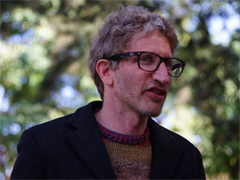The discussions among a group of residents about removing the fences around separate gardens in the interior space of their block constitute a metaphor for the everyday problems of coexistence in the city.
Taking down the fences between several separate yards to make a single, unified space of the inner courtyard of a housing block was the idea being considered by the residents who appear in the film Inner Yard. In this documentary, and with surprising economy of resources, the Czech director Marika Pecháčková portrays the political relations established in a small community and, in doing so, inevitably produces a metaphor for the everyday problems of coexistence which arise in the city.
This film of nearly 34 minutes begins with a simple travelling shot in the four streets surrounding the block, which is located in a district of Prague. The camera then moves on to a panoramic view of the courtyard while, voice-over, one of the women living in the block raises some recurrent questions in public debates on urban planning: idealisation of a past when public spaces were more human, the decisive power of architecture in influencing human behaviour, and levels of civic-mindedness in present-day society. The film’s introduction hastens to warn the viewer that this is no mere description of the particularities of a housing block courtyard and, highlighting this, Marika Pecháčková uses a strategy – a kind of meta-text – to add narrative, thus distinguishing her film from what might otherwise be an amateur video or a set of recordings made by the residents.
At a residents’ meeting called to discuss the question of removing the fences in the courtyard, personal opinions are expressed and clash, thus reflecting the political dimension of a highly sensitive question in today’s Europe, which is to say the barrier and, by extension, the idea of limit or border. Synthesised in the symbol of the fence, fears and hopes flow from the lips of the residents: isolation as a guarantee of protection and a desirable value, an idea taken to the point of paroxysm in cases like the wall constructed in Hénin-Beaumont (France); the dichotomy between the personal and the common, or public and private; fear that there won’t be enough to go round – enough garden, enough jobs, enough services – especially if “those foreigners” arrive; due observance of the rules, whether they are prohibitions or obligations; appealing to security – with pederasty as a recurrent threat; maintenance, cleaning and even hygienic requirements; the resort to participation as a way of reaching consensus; fear of noise and “antisocial behaviour”. The fences in Inner Yard are barriers whose presence or absence seems to denote the difference between Arcadia and Sodom.
It is symptomatic that all these questions are dealt with despotically, in the form of imposed restriction, a solution which very often drastically impoverishes coexistence. This is how the film approaches the paradox of neighbourliness: from the moment we join together with others to enjoy the benefits ensuing from cooperation and harmonious community life, mistrust, conflict and abuses appear, threatening coexistence. This was expressed with poetic power by the brilliant Norman McLaren in his short Neighbours (1952) which shows tragicomically how the relationship between two neighbours who are unable to share degenerates across a fence from a pleasant existence to end in death. Pecháčková brings death into the everydayness of Inner Yard:
“We moved into a flat in Prague, from which you could see the courtyard. I see it as if I’m looking at myself in a mirror and there are things I don’t want to see. A barren, insipid, empty space. Two hundred windows, two hundred families behind them and, in the middle of them all, a shared courtyard bouncing back our gazes which are drowning in its languor, day after day. Someone once said to me, ‘If you live next to something dead, death gets into you too.’”




